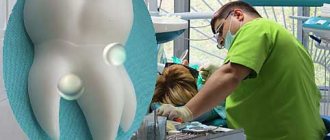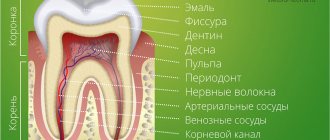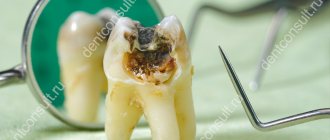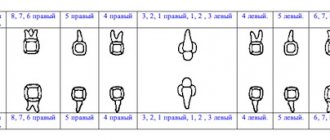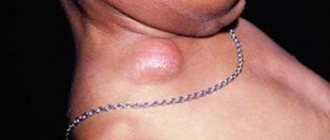Unfortunately, dental problems do not spare even the smallest children: children are often diagnosed with thinning enamel - the upper surface of the crowns is damaged, crumbled and destroyed. Enamel hypoplasia can develop against the background of disruption of metabolic processes in tissues after a viral or infectious disease in a baby or a pregnant mother.
What to do if you notice that children’s teeth have become more vulnerable and the child’s enamel has begun to deteriorate? The main thing is not to worry and start caring for your baby’s radiant smile together with the dentist.
Causes of the problem
Enamel is the hardest tissue in the body, which is continuously exposed to mechanical, thermal and chemical stress. There are many reasons for its destruction and they can all be divided into two groups: carious and non-carious.
Carious causes
Most often, it is caries that destroys teeth, and in children this happens very quickly - in a few months, snow-white milk teeth can turn into black “stumps”. Bottle caries is a problem in the first years of life, when the use of a bottle with formula or sweet liquids at night creates a favorable atmosphere for an increase in the number of bacteria, leading to the development of caries and destruction of tooth enamel.
Non-carious causes
Often teeth are destroyed due to a lack of minerals in the enamel: calcium, potassium, phosphorus, magnesium, which enter the body with food.
The main non-carious reasons why baby teeth crumble:
Enamel hypoplasia is a serious problem in which the enamel layer on a tooth may be completely or partially absent due to abnormal processes that are formed during the formation of the rudiments of teeth. The reason is a difficult pregnancy, stress, bad habits and a lack of vitamins in the body of the expectant mother.
Visually, enamel hypoplasia looks like grooves on the enamel, through which dentin shines through. Such teeth are not protected and are more susceptible to physical and chemical stress.
Fluorosis is a disease that develops due to excess fluoride in the body. The child's teeth are covered with bright white spots. This problem is caused by drinking water with high levels of fluoride content.
Non-carious lesions also include:
- poor nutrition (lack of important substances);
- lack of fat-soluble vitamins;
- high levels of phytic acid;
- excessive sugar consumption;
- excess fluoride in the body;
- enamel defects or absence;
- heredity;
- taking antibiotics during the mother's pregnancy;
- poor oral hygiene;
- the habit of chewing on everything - pencils, pens, toys, nuts, candies;
- problems of intrauterine development;
- low quality of drinking water;
- jaw injuries resulting from a fall.
Restoring crumbling teeth
Simultaneously with eliminating the root cause of the pathological process, it is necessary to take measures to strengthen crumbling teeth and restore those that have already developed defects.
- Remineralization. Treatment of teeth with a special composition based on calcium and fluoride. Effective in the early stages.
- Veneers. Thin plates that cover the front surface of the tooth. Restores appearance and prevents further damage.
- Fillings. Allows you to restore the anatomical shape and function of a tooth in case of partial destruction.
- Crowns. They are used in the most difficult cases, when most of the tooth is damaged [2].
The main rule that must be followed when teeth are crumbling is: do not self-treat. This behavior will definitely make the situation worse. Having noticed the first signs of a problem, make an appointment with the dentist as soon as possible and undergo a comprehensive examination.
List of sources
- Konovalova E. A., chief physician of the Dental Standard clinic, video blog “Why do teeth crumble? How to deal with this? // URL: https://zubnoystandart.ru/novosti/videoblog-stomatologa-pochemu-kroshatsya-zuby/ (accessed March 16, 2021).
- Pismanik V.S., chief physician of the Doctor Dent clinic, article “Why do teeth crumble?” // URL: https://www.clinikadoctordent.ru/about/articles/pochemu-kroshatsya-zuby/ (accessed March 16, 2021).
- Ogonyan V. R. Hereditary non-carious lesions of hard dental tissues. Volgograd: Federal State Budgetary Educational Institution of Higher Education "VolgSMU" of the Ministry of Health of the Russian Federation, 2022. // URL: https://rep.barsu.by/handle/data/2823 (access date 03/16/2021).
Prognosis and prevention
With adequate treatment, tooth erosion becomes much smaller, and the enamel structure is restored. After severe symptoms disappear, children should visit the dentist regularly to prevent relapse. It is recommended to minimize the consumption of products that can increase the destruction of enamel.
Erosion of tooth enamel can occur even in a child. So that the baby does not experience pain when eating and does not feel embarrassed to smile, you need to consult a dentist in time. Experienced specialists at the SM-Doctor clinic will carry out all the necessary diagnostics and select the optimal way to restore the normal structure of the enamel.
Forms of the disease
It is worth highlighting several forms:
- The color of the enamel of those teeth that were affected changes. This form is considered the easiest, because here the size of the spots is the same, and their boundaries are clearly defined. A child or an adult does not feel any discomfort, there is no pain, and there is no reaction of the teeth to irritants of a thermal or mechanical nature. Also, such stains will not take on the color of the dye;
- the enamel has not fully developed. This form of hypoplasia is already more severe. Grooves, waves, and dots appear here. If you look closely at the surface of the teeth, you can see depressions and grooves of small or medium size. The enamel in them is smooth and dense;
- enamel is completely absent. This form of the disease is also called aplasia, but it is much less common. In some part of the tooth crown there is no enamel at all. A person experiences pain and has difficulty reacting to stimuli of thermal, chemical, and mechanical types.
What is tooth enamel hypoplasia
The concept of dental enamel hypoplasia refers to a specific disease. It assumes that metabolic processes within the body are disrupted, which leads to improper formation and development of enamel. Due to disturbances in metabolic processes, the body lacks microelements that are necessary for enamel and its proper formation. The result is thin and fragile enamel. And if a load is placed on the tooth, it can quickly break.
Hypoplasia also indicates that protein metabolism and metabolic processes are disrupted. Hypoplasia can act as an independent disease or be a sign of another disease.
Is it worth treating baby teeth?
It is much more important to decide where and how to treat caries than to torment yourself with the question of why a child has bad baby teeth. Dentists are convinced that treatment of baby teeth is mandatory, and here’s why:
- the roots of the lateral milk teeth are spaced widely and cover the rudiments of permanent teeth, therefore, with pulpitis or periodontitis, the rudiment of the molar tooth may die;
- a carious cavity is a source of infection, in which any manipulation is prohibited (for example, ordinary caries can cause a ban on planned or unscheduled surgery if it is suddenly needed);
- It is impossible to correct a bite in the mouth with untreated teeth.
If this problem has affected you, do not panic: make an appointment with a good pediatric dentist and ask him all the questions that interest you. The main thing is to keep the situation under control!
Stages and features of treatment of tooth enamel erosion
Treatment of this disease is a rather long and complex process, the success of which often depends on the stage of its development. Based on this, appropriate treatment methods are selected.
Based on the intensity and depth of the lesion, the following stages of the disease are distinguished:
- Initial. Not visually detectable. The top layer is affected.
- Average. The disease becomes visually noticeable, there is a pronounced whitish tint, and all layers of enamel are susceptible to destruction.
- Heavy. The entire enamel is affected, the upper layer of dentin is involved.
It is important to understand that this pathology does not appear immediately, but gradually destroys the enamel and leads to serious consequences.
The disease can be identified by a number of symptoms:
- loss of the original shine of the enamel;
- change in tooth color;
- tooth sensitivity, pain when exposed to hot/cold food. This is explained by the appearance of a cavity in the affected area, which reacts to thermal changes and causes a corresponding painful reaction;
- the contours of the teeth are unnaturally transparent in appearance.
If such symptoms occur, you should make an appointment with the dentist.
How to strengthen enamel at home?
To protect the enamel from damage, it is recommended to follow a balanced diet (the diet should contain foods containing calcium - fermented milk products, almonds, hazelnuts, beans, peas, meat, hard cheeses, oatmeal and barley), and take vitamins with calcium.
Special toothpastes (for example, Vivax Dent, Elmex, ApaCare, Lacalut) and gels (ROCS, Amazing White Minerals) are also indicated.
Do not forget that the result of treatment depends on the professionalism of the dentist. On our website you can find a list of clinics that successfully treat this disease.
Structure of a temporary tooth
Parents cite the lack of roots and nerves as one of the reasons for not treating baby teeth, although temporary and permanent teeth have a similar structure:
- crown – the visible part of the tooth;
- root – located inside the gum;
- the nervous system, also hidden in the gum.
During the period of change, the roots of baby teeth actually dissolve, which is why the above-mentioned false opinion arose. In fact, a diseased temporary tooth hurts and decays in the same way as a permanent tooth in an adult.

